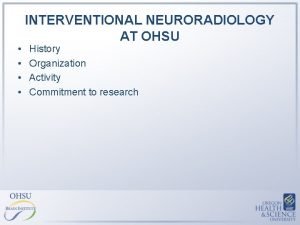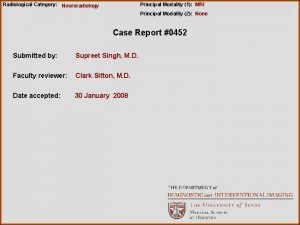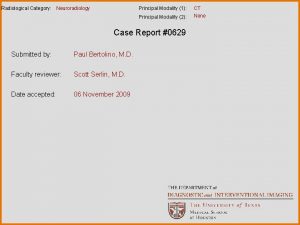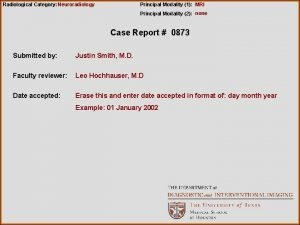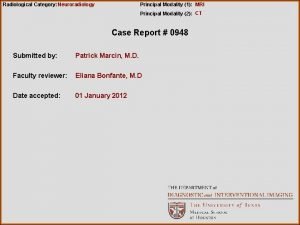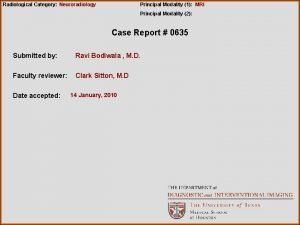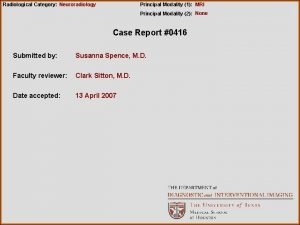Radiological Category Neuroradiology Principal Modality 1 MRI Principal








- Slides: 8

Radiological Category: Neuroradiology Principal Modality (1): MRI Principal Modality (2): none Case Report # 744 Submitted by: Sarah Martaindale, M. D. Faculty reviewer: Jeanie Choi, M. D Date accepted: 3 January, 2011

Case History 2 month old male with enlarging head size and hydrocephalus seen on ultrasound, currently with a shunt in place. The patient was born at 32 weeks and required resuscitation at birth.

Radiological Presentations Axial GRE MRI

Test Your Diagnosis Which one of the following is your choice for the appropriate diagnosis? After your selection, go to next page. • Superficial Siderosis • MRI artifact • Neurocutaneous melanosis

Findings and Differentials Findings: There is communicating hydrocephalus with dependent dark signal in both lateral ventricles representing clot (additional history of right caudate hemorrhage and IVH as a newborn). There is a hypointense border along the brainstem, cerebellum, tentorium, and lining the ventricles, almost as if traced with a pencil. The nondependent dark structure in both lateral ventricles is choroid plexus. Differentials: • Superficial siderosis • MRI artifact • Neurocutaneous melanosis/melanoma

Discussion Repeated IVH or SAH leads to hemosiderin deposits on the meningeal surfaces of the brain, brainstem, spinal cord, and cranial nerves (especially CN VIII). The severity of MRI findings do not correlate with severity of disease. If seen, one must identify and treat any underlying cause for SAH (bleeding neoplasm, aneurysm, vascular malformation, traumatic nerve root avulsion). If no cause is identified on brain MRI, the spine should be evaluated. Bilateral sensorineural hearing loss is most common presenting symptom of siderosis. Other symptoms include ataxia, anosmia, headache, hyperreflexia, and bladder disturbance. The combination of hydrocephalus and hypointense border along the meningeal surfaces makes siderosis the most appropriate answer. Neurocutaneous melanosis is a rare congenital syndrome, which can have diffuse leptomeningeal involvement, and will be hypointense on GRE sequences due to melanin content. However, this also demonstrates diffuse leptomeningeal enhancement (which this case did not have). Clinically, patients have large or multiple cutaneous melanocytic nevi, and the appropriate clinical history is key. These patients are screened with MRI starting at 6 months of age. If MRI artifact is suspected, it should persist on multiple sequences. In this case, no corresponding abnormality was seen on additional sequences.

Diagnosis Superficial siderosis with hydrocephalus secondary to intracranial/intraventricular hemorrhage.

References 1. Fearnley JN, Stevens JM, Rudge P. Superficial siderosis of the central nervous system. Brain 1995; 118(4): 1051 -1066 2. Kumar N. Neuroimaging in superficial siderosis: an in-depth look. AJNR 2010; 31: 514 3. Kumar N. Superficial siderosis: associations and therapeutic implications. Arch Neurol 2007; 64(4): 491 -496.
